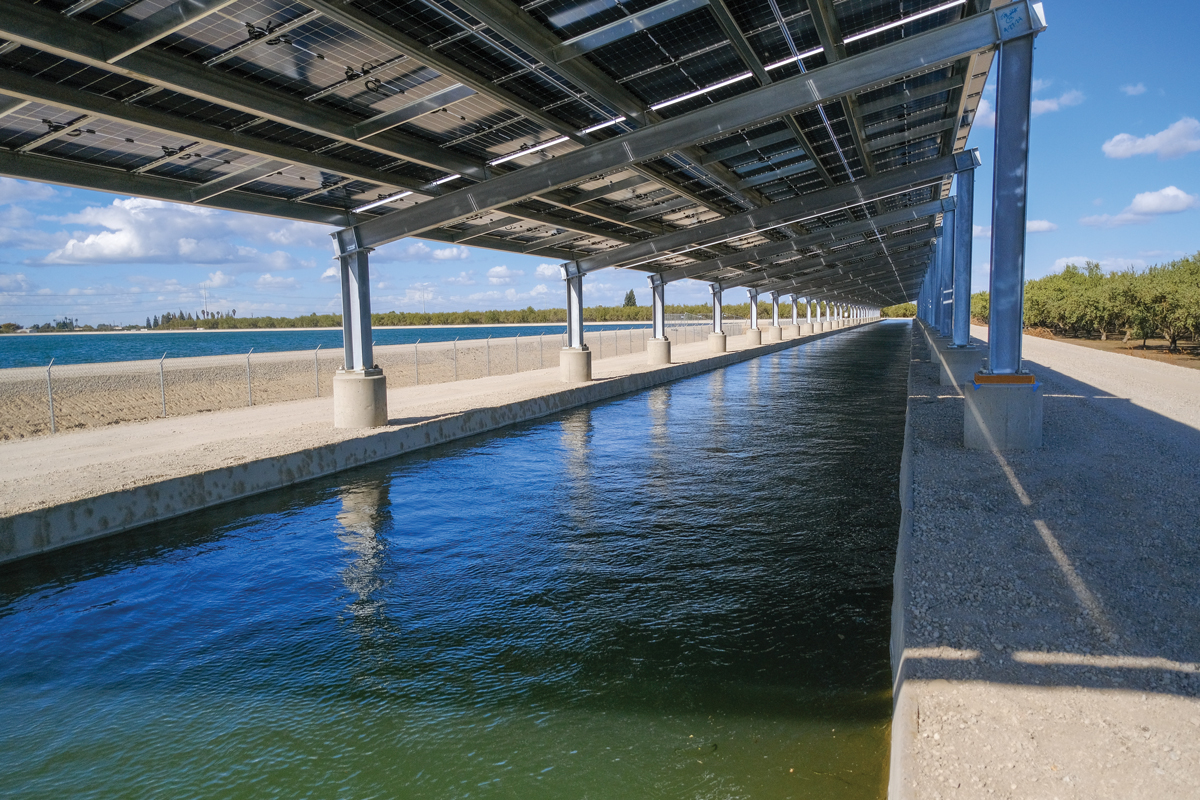Solar panels over canals could provide benefits beyond energy
DOI: 10.1063/pt.qftq.ycwu

Solar panels shade a Turlock Irrigation District canal in Stanislaus County, California. Researchers studying pilot projects in California and Arizona are quantifying the advantages and disadvantages for water and land conservation. (Photo courtesy of Turlock Irrigation District.)

Building new solar photovoltaic farms in the US has become cost-competitive with new fossil-fuel projects
Two newly constructed solar photovoltaic projects over irrigation canals, in California and Arizona, offer insights into a water-based solution. The projects’ scientists are conducting cost-benefit analyses of the energy and environmental benefits to see if they outweigh the considerable installation costs.
One of the new projects is a pilot built as part of the Turlock Irrigation District, an agricultural community in California’s Central Valley where land comes at a premium. The $20 million solar farm began generating electricity across a 6-meter-wide canal earlier this year, and energy generation at its other site (over a 34-meter-wide canal) will come online later this year. The 1.6-megawatt installation will be enough to power 60 homes for the region’s existing customers, says Brandon McMillan of Turlock Irrigation District.
The other pilot is run by Arizona’s Gila River Indian Community, which plugged in its $6 million solar project over a 9-meter-wide canal last November. Project director David DeJong says the 1.3-megawatt, nearly 1-kilometer-long installation produces power for the community and offsets costs for its irrigation district. “For the community, land is sacred, and the canal is already disturbed, so placing solar panels over them does not disturb any additional land,” says DeJong.
Scientists at both sites are measuring meteorological parameters, solar panel performance, water quality, and other metrics. Solar power over canals could reduce evaporative losses from the canals, according to a 2021 feasibility study
The data will help researchers determine if the benefits of solar panels over canals outweigh the high costs of the steel, cable-mounting components, and other building materials. The solar panels shade the canal, repressing algal growth that clogs the canal’s outlets. In turn, the water cools the air below the solar panels, increasing solar panel efficiency (which decreases at extreme temperatures) and lessening solar panel degradation.
DeJong estimates that mounting solar panels over the canal is 33–40% more expensive than doing so on land, but he argues that the economic and social benefits of water, energy, and land conservation and gains from higher solar panel efficiency will partially or fully offset the cost.
In 2012, India became the first country to install solar power over canals. The 1-megawatt pilot in the state of Gujarat inspired some small-scale copycats within the country, but large-scale projects haven’t materialized, partly due to high costs of mounting the panels, according to reporting by Mongabay India
Much of the western US is facing a severe water shortage: Years of overuse along with drought and higher-than-average temperatures exacerbated by climate change have reduced water availability to record lows. Based on their Nature Sustainability analysis, McKuin and colleagues project that covering California’s 6300 kilometers of canals with solar panels could save up to 240 billion liters of water annually, enough for the homes of 2 million people. DeJong estimates that expanding the Gila River Indian Community’s solar pilot project to cover all its Casa Blanca Canal would save enough water to irrigate about an additional third of a square kilometer annually and power 70% of the community’s energy needs (excluding its casinos).
University of Exeter renewable energy researcher Aritra Ghosh says that the US projects “serve as a valuable case study not only for solar energy programs in the US but also for academic and research institutions worldwide.” Ghosh is not involved with either project.
The final analysis of the California-based project, which is funded by the state and led by the University of California, Merced, is expected to be completed by the middle of next year. National Renewable Energy Laboratory scientists studying the Gila River Indian Community’s solar project plan to publish results annually for the next three years as the system is evaluated.
This article was originally published online on 30 July 2025.
More about the Authors
Jenessa Duncombe. jduncombe@aip.org

